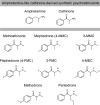DARK Classics in Chemical Neuroscience: Cathinone-Derived Psychostimulants
- PMID: 29714473
- PMCID: PMC6197900
- DOI: 10.1021/acschemneuro.8b00147
DARK Classics in Chemical Neuroscience: Cathinone-Derived Psychostimulants
Abstract
Cathinone is a plant alkaloid found in khat leaves of perennial shrubs grown in East Africa. Similar to cocaine, cathinone elicits psychostimulant effects which are in part attributed to its amphetamine-like structure. Around 2010, home laboratories began altering the parent structure of cathinone to synthesize derivatives with mechanisms of action, potencies, and pharmacokinetics permitting high abuse potential and toxicity. These "synthetic cathinones" include 4-methylmethcathinone (mephedrone), 3,4-methylenedioxypyrovalerone (MDPV), and the empathogenic agent 3,4-methylenedioxymethcathinone (methylone) which collectively gained international popularity following aggressive online marketing as well as availability in various retail outlets. Case reports made clear the health risks associated with these agents and, in 2012, the Drug Enforcement Agency of the United States placed a series of synthetic cathinones on Schedule I under emergency order. Mechanistically, cathinone and synthetic derivatives work by augmenting monoamine transmission through release facilitation and/or presynaptic transport inhibition. Animal studies confirm the rewarding and reinforcing properties of synthetic cathinones by utilizing self-administration, place conditioning, and intracranial self-stimulation assays and additionally show persistent neuropathological features which demonstrate a clear need to better understand this class of drugs. This Review will thus detail (i) historical context of cathinone use and the rise of "dark" synthetic derivatives, (ii) structural features and mechanisms of synthetic cathinones, (iii) behavioral effects observed clinically and in animals under controlled laboratory conditions, and (iv) neurotransmitters and circuits that may be targeted to manage synthetic cathinone abuse in humans.
Keywords: Addiction; cathinone; designer drugs; dopamine; novel psychoactive substance(s); reward; synthetic cathinone(s).
Conflict of interest statement
The authors declare no competing financial interest.
Figures



References
-
- Alles GA, Fairchild MD, Jensen M, Alles A. Chemical pharmacology of Catha edulis. J Med Pharm Chem. 1961;3(2):323–352. - PubMed
-
- Numan N. Exploration of adverse psychological symptoms in Yemeni khat users by the Symptoms Checklist-90 (SCL-90) Addiction. 2004;99(1):61–65. - PubMed
-
- Gosnell BA, Yracheta JM, Bell SM, Lane KE. Intravenous self-administration of cathinone by rats. Behav Pharmacol. 1996;7(6):526–531. - PubMed
-
- Kalix P. Pharmacological properties of the stimulant khat. Pharmacol Ther. 1990;48:397–416. - PubMed
Publication types
MeSH terms
Substances
Grants and funding
LinkOut - more resources
Full Text Sources
Other Literature Sources

